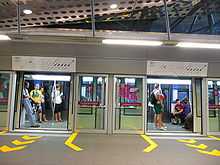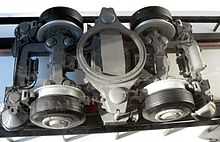Lausanne Metro
| Lausanne Metro | |||
|---|---|---|---|
 | |||
| Background | |||
| Locale | Lausanne | ||
| Transit type | Light rail, Rapid transit[1] | ||
| Number of lines | 2 | ||
| Number of stations | 28 | ||
| Operation | |||
| Began operation | 1991 | ||
| Operator(s) | TL | ||
| Technical | |||
| System length | 15 km (9 mi) | ||
| Track gauge | 1,435 mm (4 ft 8 1⁄2 in) | ||
| |||
The Lausanne Metro system includes two lines in Lausanne, Switzerland, owned by two distinct companies and operated by a third. The Line M1 is a light metro, while the Line M2 is a fully automated metro which opened on 27 October 2008. A third line M3 is in planning. Lausanne has replaced Rennes as the smallest city in the world to have a full metro system.
Line M1
Line M1 | |||
|---|---|---|---|
 Interior of a line M1 train | |||
| Overview | |||
| Type | Light rail | ||
| System | Lausanne Metro | ||
| Locale | Vaud, Switzerland | ||
| Termini |
Lausanne-Flon station Renens railway station | ||
| Stations | 15 | ||
| Daily ridership | 43,500 (university term-time)[2] | ||
| Operation | |||
| Opening | 1991 | ||
| Owner | TSOL | ||
| Operator(s) | TL | ||
| Technical | |||
| Line length | 8 km (5.0 mi) | ||
| No. of tracks | 1 (some double track sections) | ||
| Track gauge | 1,435 mm (4 ft 8 1⁄2 in) standard gauge | ||
| Electrification | Overhead catenary (750 V DC) | ||
| |||
The Lausanne Métro Line 1 was opened on 24 May 1991. The line is owned by a company named TSOL (Tramway du Sud-Ouest lausannois) and this acronym is widely used by the commuters who use the line. Trains on the line are operated by the Transports publics de la région lausannoise (TL, formerly Tramways Lausannois). The M1 is a light metro with a dozen surface stations and three underground.
The line, which is 8 km (5 mi) long, links the centre of Lausanne, the Lausanne campus (UNIL and EPFL) and Renens. The line is generally single track. At most stations a passing loop is provided to allow trains to pass, and a dedicated platform is provided for each direction. Exceptions to this are Bassenges, UNIL-Sorge and Provence stations, where the line is still single track serving one bidirectional platform.
Stations
| Station | Altitude | Situation |
|---|---|---|
| Lausanne-Flon | 479m |  |
| Vigie | 481m |  |
| Montelly | 443m |  |
| Provence | 430m |  |
| Malley | 422m |  |
| Bourdonnette | 389m |  |
| UNIL-Dorigny | 388m |  |
| UNIL-Mouline | 386m | |
| UNIL-Sorge | 391m |  |
| EPFL | 397m |  |
| Bassenges | 399m |  |
| Cerisaie | 398m |  |
| Crochy | 403m |  |
| Epenex | 410m | |
| Renens CFF | 404m |  |
Line M2
Line M2 | |||||||||||||||||||||||||||||||||||||||||||||||||||||||||||||||||||||||||||||||||||||||||||||||||||||||||||||||||||||||||||||||||||||||||||||||||||||||||||||||||
|---|---|---|---|---|---|---|---|---|---|---|---|---|---|---|---|---|---|---|---|---|---|---|---|---|---|---|---|---|---|---|---|---|---|---|---|---|---|---|---|---|---|---|---|---|---|---|---|---|---|---|---|---|---|---|---|---|---|---|---|---|---|---|---|---|---|---|---|---|---|---|---|---|---|---|---|---|---|---|---|---|---|---|---|---|---|---|---|---|---|---|---|---|---|---|---|---|---|---|---|---|---|---|---|---|---|---|---|---|---|---|---|---|---|---|---|---|---|---|---|---|---|---|---|---|---|---|---|---|---|---|---|---|---|---|---|---|---|---|---|---|---|---|---|---|---|---|---|---|---|---|---|---|---|---|---|---|---|---|---|---|---|
 | |||||||||||||||||||||||||||||||||||||||||||||||||||||||||||||||||||||||||||||||||||||||||||||||||||||||||||||||||||||||||||||||||||||||||||||||||||||||||||||||||
| Overview | |||||||||||||||||||||||||||||||||||||||||||||||||||||||||||||||||||||||||||||||||||||||||||||||||||||||||||||||||||||||||||||||||||||||||||||||||||||||||||||||||
| Stations | 14 | ||||||||||||||||||||||||||||||||||||||||||||||||||||||||||||||||||||||||||||||||||||||||||||||||||||||||||||||||||||||||||||||||||||||||||||||||||||||||||||||||
| Operation | |||||||||||||||||||||||||||||||||||||||||||||||||||||||||||||||||||||||||||||||||||||||||||||||||||||||||||||||||||||||||||||||||||||||||||||||||||||||||||||||||
| Opening | 2008 | ||||||||||||||||||||||||||||||||||||||||||||||||||||||||||||||||||||||||||||||||||||||||||||||||||||||||||||||||||||||||||||||||||||||||||||||||||||||||||||||||
| Technical | |||||||||||||||||||||||||||||||||||||||||||||||||||||||||||||||||||||||||||||||||||||||||||||||||||||||||||||||||||||||||||||||||||||||||||||||||||||||||||||||||
| Line length | 6 km (3.7 mi) | ||||||||||||||||||||||||||||||||||||||||||||||||||||||||||||||||||||||||||||||||||||||||||||||||||||||||||||||||||||||||||||||||||||||||||||||||||||||||||||||||
| Track gauge |
1,435 mm (4 ft 8 1⁄2 in) standard gauge with running pads for the rubber tired wheels outside of the steel rails | ||||||||||||||||||||||||||||||||||||||||||||||||||||||||||||||||||||||||||||||||||||||||||||||||||||||||||||||||||||||||||||||||||||||||||||||||||||||||||||||||
| |||||||||||||||||||||||||||||||||||||||||||||||||||||||||||||||||||||||||||||||||||||||||||||||||||||||||||||||||||||||||||||||||||||||||||||||||||||||||||||||||



The Lausanne Métro Line M2 uses the track formerly used by the Lausanne-Ouchy, and then a brand new extension towards Epalinges, crossing the whole city of Lausanne from north to south.
History
- Complementary enquiry : September 2001
- Decision by the State Council : June 2002
- Funding requested from the High Council : September 2002
- Popular vote : end 2002
- Metro-Ouchy operations stopped : January 2006
- Duration of construction : 4 to 5 years
- Official Inauguration : 18 to 21 September 2008
- In operation from : 27 October2008
Technical
- Mostly in tunnel.
- Rubber-tyred metro with the steepest slopes in Europe.
Characteristics of the line
- (6 km (3.7 mi) from Ouchy to Epalinges, including 1.5 km (0.93 mi) replacing the former Lausanne-Ouchy.
- 14 stations.
- 360 m (1,180 ft) slope (375 m or 1,230 ft) slope.
- 5.7% slope average with maximum of 12%. The constraints in braking distance and deceleration are such that the M2 can travel faster upwards than downwards.
Performances
- 25 million passengers/year (forecast).
- 37 000 jobs serviced.
- 37 mph (60 km/h) top speed.
- 18 minutes from one end of the line to the other.
- Up to 6 600 passengers/hour in each direction.
- One train every 3 minutes between the main railway station and La Sallaz (every 6 minutes along the rest of the line).
A rubber-tyred metro
A rubber-tyred metro is able to climb at high speed the Lausanne slopes (12% in some places ; 5.7% average on the whole line).
Automated metro
The Line M2 is entirely automated, managed from a central command station. This means that it is cheaper to operate and more flexible during peak hours. The stations are equipped with platform screen doors and dedicated station personnel are on hand to assist passengers.
A separated right of way line
The M2 runs on its own right-of-way, with a double track (except in the tunnel under the CFF station due to high costs), underground for most (70%) of the route. The metro is the ideal solution to the security and congestion problems of the urban public transportation, since the subway can run without interfering with surface traffic.
Safe and practical stations
The underground stations are located as close as possible to the surface. They are equipped with stairs, lifts and facilities for handicapped people. The Lausanne slopes have been used to create multi-level access, make ramp access easier and take advantage of natural light as much as possible .
Trains

- Articulated vehicles with 4 powered bogies.
- 222 passengers, 62 seated.
- Rubber-tyred metro with lateral guidance based on the MP 89 from Paris Métro.
- Fully automated (Meteor).
Technical data of the trains
- Length of a train : 30,680 mm (100 ft 7.9 in)
- Length of a car : 15,340 mm (50 ft 3.9 in)
- Width of a car : 2,450 mm (8 ft 0.46 in)
- Height of the car to ground level: 3,470 mm (11 ft 4.61 in)
- Mass of an empty train : 57,316 kg (126,360 lb)
- Mass of a train at maximum load (4 p/m²) : 72,856 kg (160,620 lb) (¹)
- Width of the access doors : 1,650 mm (5 ft 4.96 in)
- Height of the access doors : 1,900 mm (6 ft 2.80 in)
(¹) Calculated with an average of 70 kg (154 lb) per passenger.
Capacity of the trains
| Number of passengers/m² | Passengers per train | |
|---|---|---|
| Nominal load | 4 pax/m² | 222 |
| Full load | 6 pax/m² | 314 |
| Maximum load | 8 pax/m² | 406 |
Delivery of the trains
The first train was delivered on 2 March 2006 in Lausanne. Since then, all the other trains have been delivered at a rate of two per month. When they arrived, the trains were stored in the CFF storage of Lausanne. Then, by autumn of 2006, the subway workshop facility having been completed, the vehicles were moved finally to the Vennes facility.
Accidents
On 23 February 2005, part of the tunnel under construction collapsed under the Saint-Laurent square in the centre of Lausanne. More than 500 m³ of debris (water and earth) fell into the tunnel, forming a huge fifteen metre gap. The area was completely evacuated for a few days and consolidation and geological analysis work started. A large pocket of water had not been noticed during the initial explorations.
Repair work lasted for a few months. The incident fortunately had no major consequence; nobody was in the area of the collapse which had heavily damaged a shopping mall. Part of the budget had been allocated for such risks and the deadline for the construction in December 2008 was not directly affected.
On 27 October 2006, a construction worker died from injuries. He had fallen a few days before on the construction site at the level of the entrance of the University Hospital of Lausanne (CHUV).
On 28 July 2008 a high level manager for Alstom who had responsibility for the security system for the new lines was found hanging in the stairwell at the entrance to the Vennes station of the M2. The 45-year-old French man's death appeared to have been a suicide.[3]
Stations
|
 |
Possible extensions
The end station Les Croisettes has been designed to allow a future extension of the line to the north towards Epalinges-Village, or even Le Chalet-à-Gobet.
Line M3
A line M3 is proposed to serve the new development area of La Blécherette [4] and the west of Lausanne (Malley, Renens Bussigny). Line M3 could be a metro similar to the M2 and would be in correspondence with M1, M2 and LEB railway at the station Lausanne-Flon. The M3 could take over the M2 line from Ouchy to Lausanne Gare and a new terminus for the M2 would be established.[5]
Former Lausanne-Ouchy line

The Lausanne-Ouchy railway was inaugurated in 1877 as a funicular. In 1959 the first overhaul took place by transforming the funicular into a rack railway under the name "métro". At that time, Flon and Gare CFF stations were demolished and replaced by concrete underground equivalents. The line was however always nicknamed "La Ficelle" (The String) by its users due to its funicular past and circulation above ground in the greenery for more than half of its run.
Connected to the Flon facilities, the freight trains from the main station to the storage area of the harbour (in Flon) travelled through this line until the construction of a direct connection between the freight station of Sébeillon and the Flon valley in 1954.
The line was finally closed to all traffic on 21 January 2006. The rolling stock will be sold to the French city of Villard-de-Lans which foresees the construction of a new rack railway, La Patache to ensure a link between the center of Villard and Le Balcon de Villard in 2008.
A bus service was put into operation to replace "La Ficelle" until the opening of the new metro M2. This service was called Métrobus (MB): the south loop linked Ouchy to the CFF station and the north loop linked the station to Montbenon (which is located right above the Flon area).
Network
- 2 parallel lines
- Ouchy - Jordils - Montriond - CFF Station - Flon (Métro-Ouchy)
- CFF Station - Flon (Métro-Gare)
Characteristics
- Ouchy - Flon
- length 1568 yards (1482m)
- altitude differential 106 m
- slope 11,6%
- train every 8 minutes
- CFF Station - Flon
- length 318 m
- altitude differential 37 m
- slope 12%
- continuous circulation without timetable
History
- 1877, creation of the funicular Ouchy - CFF Station - Flon
- 1879, creation of the funicular CFF Station - Flon, parallel to the initial one
- Traction cables driven by water turbines in the top station
- 1954-1958, transformation of the line to the rack mode
- 1984, sold to the city of Lausanne
- 21 January 2006, end of the operations to allow the conversion into Metro M2 and extension to Epalinges
- 19 September 2008, inauguration of the M2 line
See also
Notes and references
- ↑ The Lausanne Metro has two lines. Line 1 is light rail, line 2 is rapid transit.
- ↑ "m2 – plus de 100'000 voyageurs en deux jours" (PDF) (in French). Transports publics de la région lausannoise. 29 octobre 2008. Retrieved 22 September 2012.
- ↑ (French) http://www.lausanne.ch/view.asp?DocId=29628
- ↑ http://www.agglo-lausanne-morges.ch/Documents/Doc_17_janv_2008/PALM-dossier-axes-forts-170108.pdf
- ↑ Le M3, qui passera ici ou par là, cherche encore sa voie - 24 heures
External links
| Wikimedia Commons has media related to Lausanne metro. |
- (French) Transports Lausannois (TL)
- (French) Métro de Lausanne
- (French) Site non officiel du m2 (Photos, Infos)
- (English) Métro de Lausanne par Urbanrail
- (French) Le Lausanne-Ouchy (Photos)
- (French) LO - Métro Lausanne-Ouchy (Photos)
- (English) Lausanne-Ouchy
- (French) Article sur Jean Perret, père du chemin de fer à crémaillère
- (French) galerie www.photos-trains.ch
- (French) Une petite recherche sur la compagnie du Lausanne-Ouchy et la gare de Sébeillon, par Julien Sansonnens
- (French) Carto.Metro : plan détaillé du métro (voies, ateliers,..)
- (English) Photogallery of M2 in Lausanne
- (English) Métro Lausanne at public-transport.net
| |||||||||||||||||||||

